Elizabeth I stands out from the crowd of monarchs, being both a departure from the rest of the Tudor dynasty as well as exemplifying her family’s best (and sometimes worst) qualities. She is a complex figure, full of romanticism and intrigue as well as a staunch political figure and determined ruler. Appearing countless times in film and television, she is portrayed by talented actresses, from Cate Blanchett to Quentin Crisp. Each one has their own unique take on the famous queen, many going on to receive awards and accolades for their portrays.
As an enthusiast of these period dramas, I have dedicated hours of my life to these films. While I won’t make any arguments for the historical accuracy of them, (mostly because I don’t want this to be a fifty-page article), I love getting swept up in the pageantry and drama. After spending so much time in the setting of the Tudor era, I have noticed an interesting methodology behind the people who portray Elizabeth I. While each incarnation adds something new, they follow a formulaic approach to the character that can be split up into three general categories. That of Young Elizabeth, Old Elizabeth, and the Immortal Elizabeth. I went back to re-watch some of my favorites, and the trend continued to establish itself.
Young Elizabeth
Films Referenced: Elizabeth (1998), Elizabeth: The Golden Age (2007), Elizabeth R (1971)
One of the more popular depictions is that of the young Elizabeth. It’s no surprise that we flock to this time of her life. Before she took the throne, Elizabeth’s young life was one of turmoil. Pushed from the line of succession, her life was threatened on all sides. Some sought to use her as a tool for their own political machinations. Others saw her as a rival and wanted her out of the picture permanently. It’s a setting rife with conflict, and who better to set in the middle than a lovely, charming young actress with whom the audience can sympathize and root for.
In these instances, Elizabeth stands counter to her sister Mary I. Elizabeth is depicted as young, virile and bright. A symbol for the golden future of England. Mary is shown as dark, aging, and often manic. She is the symbol of England’s dark, repressive past. The first rival against whom Elizabeth must fight if she is to take her rightful place on the throne, Mary is both sister and nemesis. In the beginning, the future Queen is shown as wily in her dealing with her half-sister. She chooses her words carefully and plays her cards close to the chest. This bravery endears her, and her cause, to us.
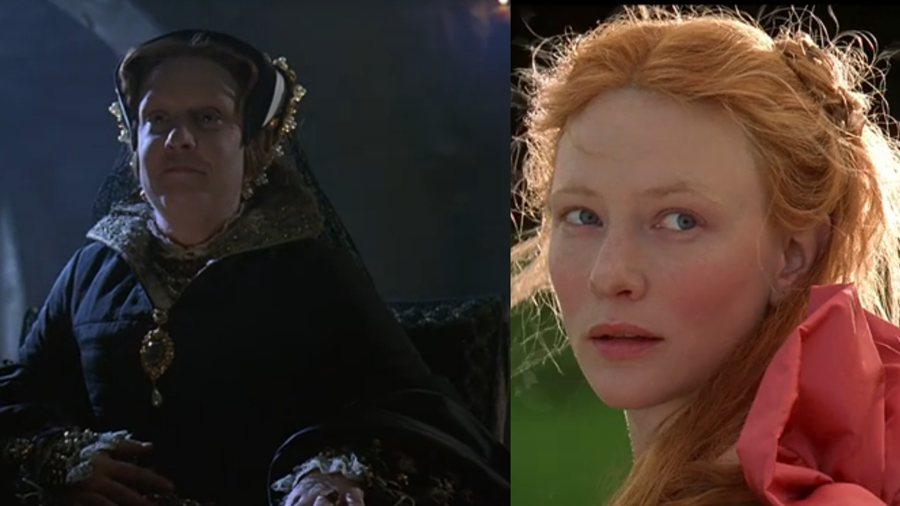
She is told most often that she is ‘innocent in the ways of this world’ (Elizabeth 1998) and encouraged to rely upon older and more experienced persons. Namely, men seeking power and control over the throne. Her confidants ask her to use caution while her political enemies try to exploit her. This further cements her innocence and purity in the eyes of the audience. But it falls counter to what we see of her when she is alone, a calculating young woman who knows full well the dangers surrounding her. I often feel it minimizes her character, but perhaps it only serves to remind us of the complex woman who rules.
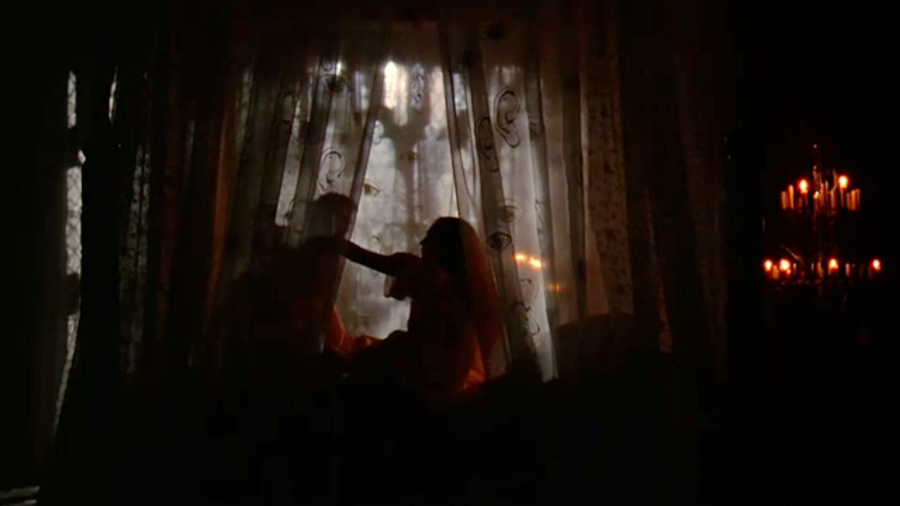
However, I notice a marked change once she becomes Queen. Her power becomes celebratory, and she removes herself from the seclusion of her own mind. She begins to resemble her late father, Henry VIII, throwing grand parties and indulging herself in the trappings of being a Queen. I often wonder if the purpose of this is to show how easily one could find themselves viewing the wealth and status as a right as opposed to a responsibility. After all, Elizabeth has earned her position, hasn’t she? She is warned by her councilors that she is in a weakened position and her throne is threatened by outside powers. Which in Elizabeth (1998) she responds to by throwing a giant party so she can meet her courtiers and see her lover Robert Dudley. However luxurious this may seem, she does not willingly throw statesmanship to the side. But her councilors often work behind her back, sometimes to her benefit and sometimes to her chagrin. This serves as a reminder that despite her assumed power, she is still new to the world of ruling and must be more exacting with her behavior.
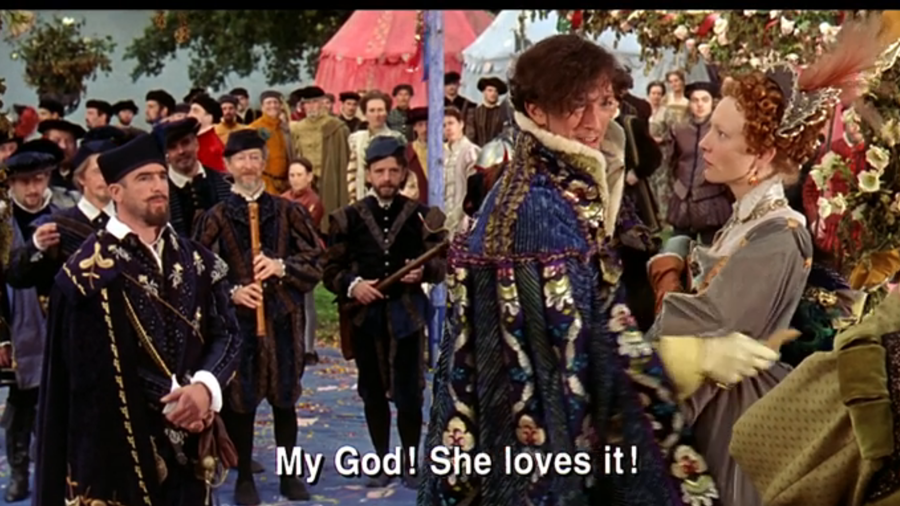
There is also a lack of respect shown to her consistently throughout the dramatizations by her councilors. They are often shown to be speaking over her, something which never would have been acceptable from a subordinate to their monarch. They overstep their boundaries, lending to the uncertainty that exists when a new ruler takes power. You begin to understand how unbalanced and insecure she must feel. To have fought through so much only to discover that the battle isn’t over yet. Not only must she fend off foreign interests, but the disrespect and doubt of her own people.
In the movies depicting young Elizabeth, we see a woman struggling with the balance of power. Finding that if the throne is not made for her, she must make herself fit for the throne. It is a decision she finds painful because it requires sacrifice. A sacrifice of the self to what she feels is a higher purpose. In the end, Elizabeth can not win. It must be England who triumphs. And in many productions, this transition is established by the sight of her in the familiar regalia we know her from. The white-faced, red-haired sovereign who shows her determination to rule by her declaration to sit unmarried on the throne.
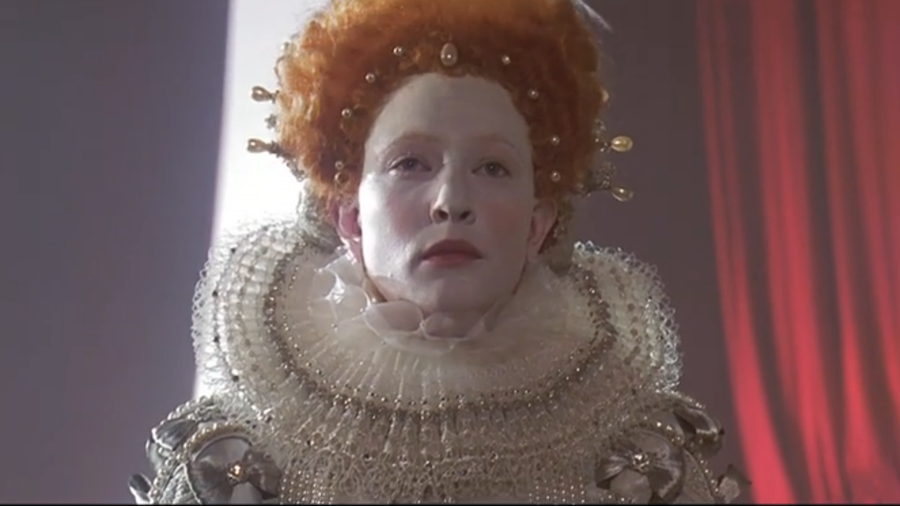
Old Elizabeth
Films Referenced: The Virgin Queen (1955), Elizabeth I (2006), Elizabeth R (1971)
In the media concerning the reign of Elizabeth, there is frequently a break between depictions of the Queen. She is rarely if ever depicted as middle-aged. She is either young or old, splitting her life into two halves separated by time and events. As such, the women depicting her must change, save in the case of Cate Blanchette who is ageless. I find most people make this distinction right around the time of England’s defeat of the Spanish Armada in 1588. They seem to enjoy skipping to this point, casting a classic actress such as Helen Mirren, Judi Dench, or Bette Davis.
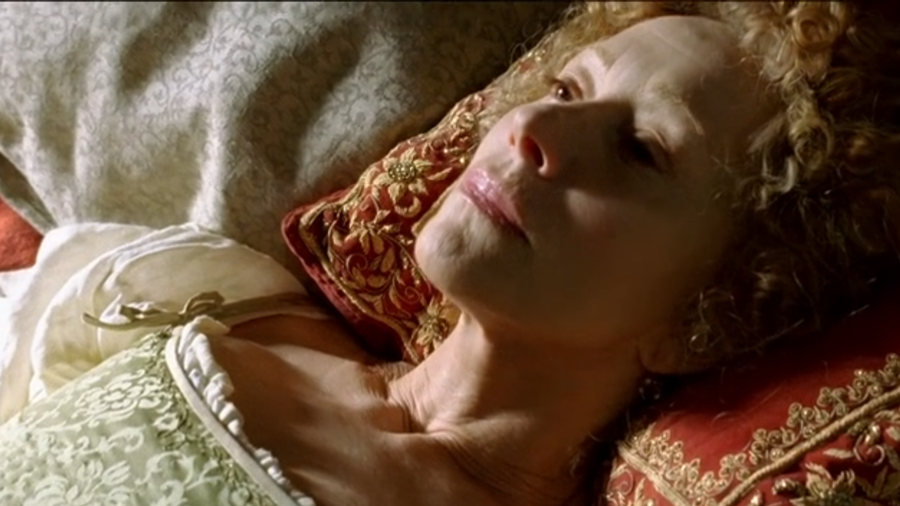
The Queen was in her 50’s at the time and had been on the throne for thirty years. We see a marked change in her demeanor, showing a woman who has found her legs sturdily underneath her. She has lost none of her charm and grace, but there is a wariness to her that was not there before. Her rule is, as ever, full of plots. Always the threat of the Catholics against her from Spain to France and even from within her own family tree. The pitting of woman against woman is a common theme in royal dramas and even with Spain at her doorstep, the fifty-year-old queen is put reluctantly at opposition to her cousin, Mary Queen of Scots.
Where before we saw the polar opposites of the dark and dour Mary I vs the bright and youthful Elizabeth, we now find ourselves given the sight of a young and fertile Queen of Scotland against the aging Queen Elizabeth. This, of course, depends greatly upon who is making the show/film. I’ve noticed British productions are much less favorable towards Mary than Western ones. Jealousy sits as an unspoken guest between them. Elizabeth is sometimes depicted as being silly or undignified by dressing as if she were still a girl. She is shown as flirting foolishly and mocked for not acting her age, but it often seems to hide a more complex ploy. Through her seeming mercurial moods, she keeps everyone at arms length. She’s learned who to trust and how far to trust them.
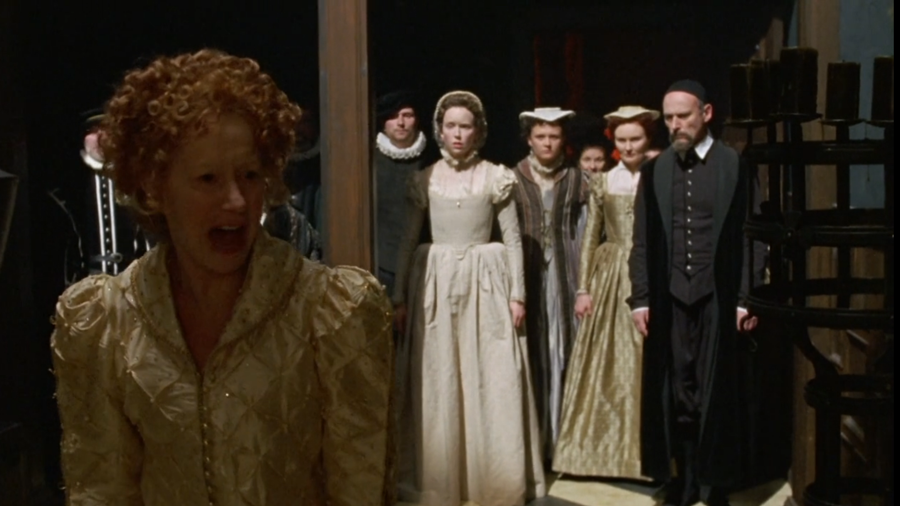
This stands in contrast to her cousin, who seemingly has everything Elizabeth wants but can not take for herself. Mary, Queen of Scots has a husband and child, but her reign is to end in tragedy. Even though the two never meet face to face, (no matter what Mary, Queen of Scots in 2018 portrays), the actress of Elizabeth must portray a quiet ire mingled with longing when it comes to the reflection of herself she finds in her cousin. The valor and glory of a Queen before a victorious army is easy but the pain of a woman who sees her life pass her by as it might have been? Oh so much harder to make clear in a glance.
I generally like the dignity of Elizabeth in the second half of her reign. This is when you see the actresses show their range as a performer, building on the complexity of the woman and the Queen. She must be a formidable force and yet still be a person who longs and loves. She must be ruthless and, yes, even cruel, and then still you have to pity her and sympathize with her actions. Historians can debate her motivations back and forth till they are blue in the face but in the end, the actress must portray her with certainty. There is always regret, and I think that says the most about a Queen who rules against such odds for such a very long time. How could anyone sit at the head of a country without having some regret in their soul for their actions, necessary or not?
There is also a tendency to show the elder Elizabeth as a bitter and world-weary, especially in the media that depicts her in her final days. The historical queen has often been described as paranoid and prone to figments during her final years. Understandable, given the weight of the world she carried on her shoulders for forty-four years. Who could avoid becoming a little on the paranoid side after all of that? The end of Elizabeth’s life always has the ring of a grand tragedy. It pulls the audience into the figure she was and all that she represented, allowing them to mourn her passing as many must have so long ago.
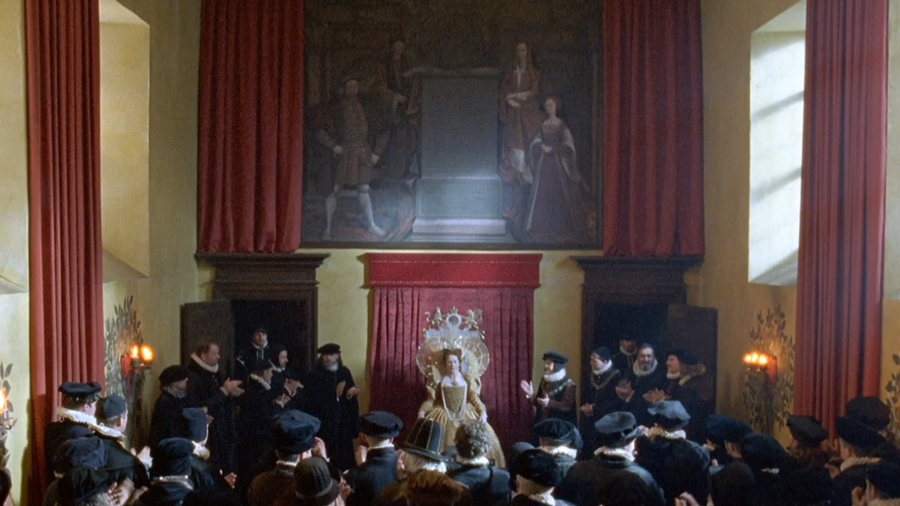
Immortal Elizabeth
Films Referenced: Orlando (1992), Shakespeare in Love (1998), Anonymous (2011)
The final depiction I see, and not often enough, is the immortal Elizabeth. In its way, the immortal Elizabeth endured in a way the other two cannot. She exists more often than not as the deus ex machina of another character’s story, such as in Shakespeare in Love (1998). In these moments, the Queen does not need to have the depth of character so much as she has to be a character. She must be easily identifiable to we the audience and meet with the idea of Queen Elizabeth I as we understand her. Judi Dench received an Oscar for Best Supporting Actress for her role in Shakespeare in Love, despite being on screen for only eight minutes. This alone shows just how powerful the role of the Queen can be!
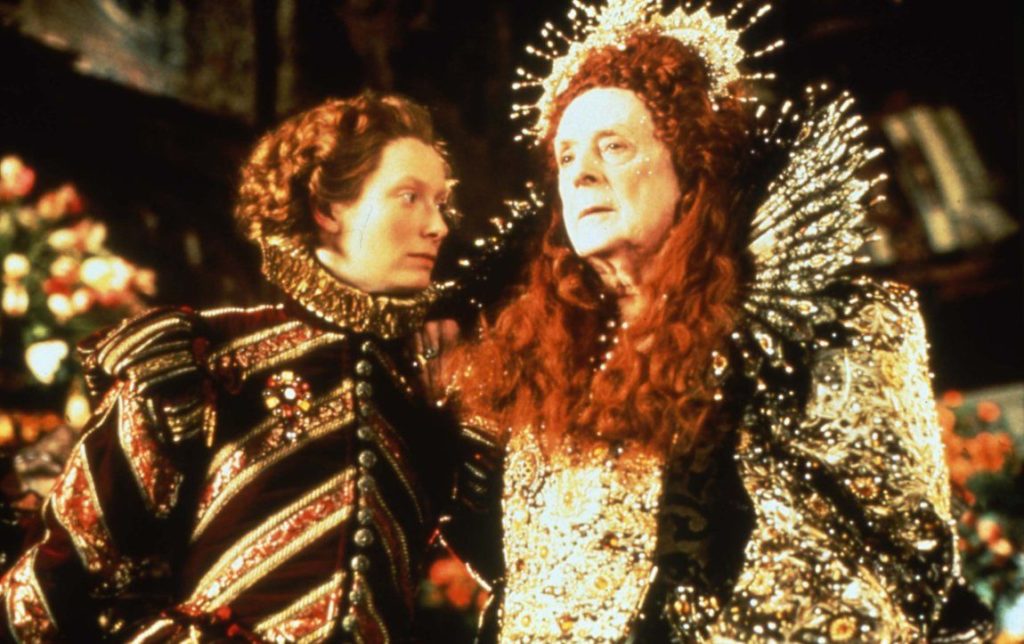
In this manner, the Immortal Elizabeth wields power in the way we expect of a Queen. No longer the victim of conflict and indecision, she displays a certainty which few posses in reality. She embodies what we believe a leader should be, not what they really are. It is very similar to the way in which we ‘stan’ a celebrity or public figure, glossing over the reality and choosing to see only the shine. This is not a bad thing. Indeed it is one of the reasons that this Queen out of so many in history has endured.
In fact, I would argue that many of our fantasy ‘queens’ from Cleopatra (1963) to Galadriel (Lord of the Rings, 2001) to Queen Ingrith (Maleficent: Mistress of Evil, 2019) seem to draw from our concept of women rulers as a whole which is often epitomized in Elizabeth portrayals. She is the closest example to how we see a romanticized historical monarch and because of this, we implant a little of that into our narratives when we create a formidable and complex female ruler.
In this way, the Immortal Elizabeth quickly becomes a personification of all Queens. Both a respect political figure to live up to as well as a complex narrative about a woman struggling against the bias of her time and the threats surrounding her. It’s a story we all relate to. I know many women who find Elizabeth in media to be an inspiring figure, reminding them to be strong despite all the struggles they must contend within their daily lives.

Bringing such an icon of history to life is no small task. It is not my intention to criticize an actor’s performance, but rather to make note of it. How Elizabeth is shown effects how we the audience perceive her and how we judge her actions through the lens of mythologized history. Everything about Elizabeth has been debated, from her motivations as a politician down to her gender. It’s no wonder we return to her again and again in television and film. Perhaps we will never fully understand the queen of the Golden Age of England. But we can sure have fun trying.
